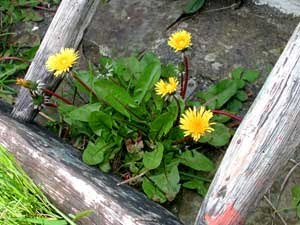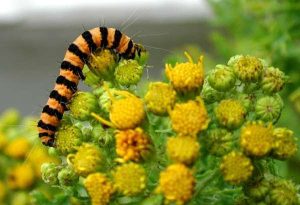Join Ireland’s Wildlife contributor Albert Nolan as he discovers the hidden wildlife gems of Limerick city.

Cities like Limerick are havens for a surprising array of wildlife (image via Wikimedia Commons)
The pleading calls of my kids tug at my heart strings as I slip into my walking gear. I see the window of the house start to fog up as little lips press against it. I’ve parked in Rossa Avenue, and the kids are staying with their Nanny for a few hours. I have promised them a trip to town, but it has been a long summer, and I need some quite time. Their walk will have to wait a while.
I hear the magic words “snacks” and “television”, and when I look up they are gone.

Surviving parenthood can be an arduous affair but here in the urban jungle nature faces its own unique challenges, and yet still manages to thrive in the most unexpected places. As I close the boot of the car I spot some pineapple mayweed growing in a small crack in the road. The fruits of this plant not only look like a pineapple, but when you squeeze them they give off a pineapple smell. In the countryside you often find it in high-traffic areas by field gates and on well-worn paths. That same ability to survive being trampled helps it to endure on our city streets too.
As I walk down the avenue I hear starlings singing from the TV aerial of a nearby house. I have seen them nesting in holes in the building, and they gain many benefits from living close to their human neighbours. Their nests are warmer in our roofs and there is a good supply of food provided by people.

On the leaves I find the black and amber banded caterpillars of the beautiful Cinnabar moth. This is a day-flying species and is black with prominent red under-wings. The striking colours serves as a warning to birds and other potential predators that this is an unpleasant insect to eat. The bright Kilkenny stripes of their caterpillars also signify danger (just like in hurling) and mean they can feed during the day without the need to lurk in the shadows.
Plants too have adapted to the harsh conditions of old stone walls. Ivy leaved toad-flax, wall rue, maiden hair spleenwort and harts-tongue fern are all growing on a stretch off wall. These hardy plants have the ability to survive long periods of drought and the challenging conditions of full sun or shade.
I head into town to do a few messages, and pass a car park that is slowly returning to nature. Sally trees and buddleias have already colonised the broken tarmac, their shed leaves creating a rich hummus where other plants can gain a foothold. I pause to tie my shoe lace and come face to face with a big spider. She has built her web at the back of a drain pipe and is struggling to subdue a solider beetle that has become ensnared. The beetle is bright orange with a black tip and gets his unusual name because it resembles a 19th century military uniform. This is just one of the daily battles for survival that take place on every street corner and tree in our cities.

At the entrance to Cruises Street I pause and gaze at a family of rooks perched on the canopy above a shop. Each of the parents has a young bird by its side. They scanning the road and path intently. After a few minutes a child spills a bag of chips and the adult rooks descent, calling to their chicks. After they have dined they return to their vantage point and await the next free meal. These young birds are learning the skills necessary for urban survival, but this also reflects a change in behaviour. Rooks are farmland birds that usually forage in grassland for soil grubs. Their intelligence and curiosity has allowed them to create a new life in the middle of the city.
I quickly finish up in town and retrace my steps back to Rossa Avenue. As I pass the prison I find bindweed climbing the front railings. Light is essential for plant growth, and bindweed’s ability to climb means it can outcompete other plants to reach this precious resource.
There are extensive grounds around St Joseph’s hospital, but I only have time for a quick visit today. Valerian is growing on the wall and has gone to seed. Cat’s-ear has bright yellow flowers like the dandelion. Its gets its unusual name from the hairs on its stems that are rough like a cat’s tongue, and the small bracts on the stems that look like cats ears.
There are fine trees in the grounds and I make a mental note to do a proper survey when time permits. I stop to examine a tall oak. These trees are brilliant for insects and I shake a few of the branches and catch a myriad of colourful creatures in my net.
White butterflies are flying, but they are moving very quickly. I wait by a flowering shrub and manage to catch a green veined white. These are common butterflies and like areas of damp grassland. Two young rooks are reverting to more natural foraging behaviour, probing for grubs in the grass.

I continue my walk and pass by the shop of Limerick community growers. An old pallet is standing against the wall, stuffed with hay and soil and then filled with colourful flowers. This is a very neat and clever idea and I will definitely try it at home in my own garden.
The flow of traffic increases inexorably, but nature can still be found on the fringes of our modern roads. There is a large green space in front of local houses, and I migrate towards the colourful flower bed. It is full of the herb thyme, a magnet for bees. I catch three different bumblebee species, Bombus pascuorum, Bombus terrestris and Bombus lucorum as they search for nectar. If half the plants in the flower beds in our community spaces and gardens were planted with nectar rich herbs it would be hugely beneficial for our beleaguered bumblebees. I also hear the chirping of a grasshopper. Over the last year I have become enchanted with these insects. I search on my hands and knees for a few minutes but have no luck in catching one this time. Swifts are flying overhead and I hear a Jackdaws chuckling call.
Across the road a wildflower margin has been left along the base of a wall. In contrast the grass by the path is kept short, showing a good example of balanced management. Meadow buttercup, ragwort, sow thistle, narrow leaved willow herb, bindweed, welted thistle, silver weed and herb robert have all taken advantage of this linear strip of habitat, which is also full of colourful cinnabar moths.
I pass under the bridge to one of the busiest junctions in Limerick. Amidst the hustle and bustle of city traffic nature thrives here too, in a wild corner between the road and the railway bridge. Buddleia bushes are lush with flowers and I can smell their beautiful scent. A small tortoiseshell butterfly is feeding on the flowers. Beneath them is a host of wildlife-friendly flowers. Bush vetch with seeds for birds, bramble with blackberries and the flowers of St Johns wort and red clover for bumblebees.

Despite its proximity the traffic fades from my mind as I follow six-spot burnet moths through the small, flower-rich meadow. These are stunning insects and will often perch on flowers to sun themselves or take a sip of nectar. Flowers are everywhere and I find meadow vetchling, narrow- and broad-leaved plantain, black medic, knapweed, selfheal and ox-eyed daisy. Bombus pascurum is busily gathering nectar and I hear the collective songs of several grasshoppers.
Meadows browns and Ringlets, typical grass land butterflies, flit between my legs and delicate spider webs hang between tall grasses. A seven-spot ladybird is resting on a white yarrow flower and teasel is in flower. I hear a goldfinch singing, and when the teasel produces seeds it will certainly attract small birds like the goldfinch. This mini-oasis is full of wildlife and should be conserved as part of Limericks overall biodiversity.
I start the walk home and call in for a visit to Mt St Lawrence. Jackdaws are feeding between the headstones and I hear a woodpigeon singing. Along the back wall I search the overhanging bramble patches. This is a great plant for insects and I find a meadow brown, Bombus pascurum, green-veined white and a large hoverfly called Volucella pellucens. A Blue tit is nimbly gathering insects.
A whole world of nature is waiting to be discovered right at our feet, even in our busiest cities. So next time you are out and about why not take a closer look, and see what wildlife you can find living on your street.
Comments/questions to [email protected] or 089 4230502. Also available to give walks/talks to schools, tidy towns, community or youth groups.









